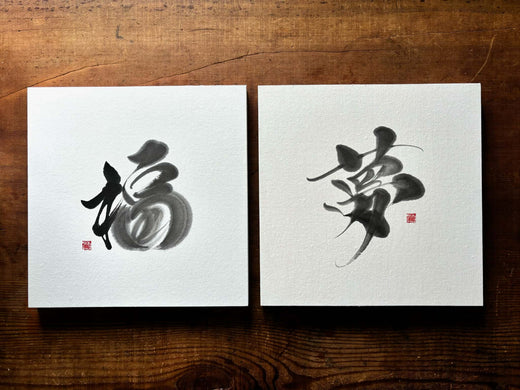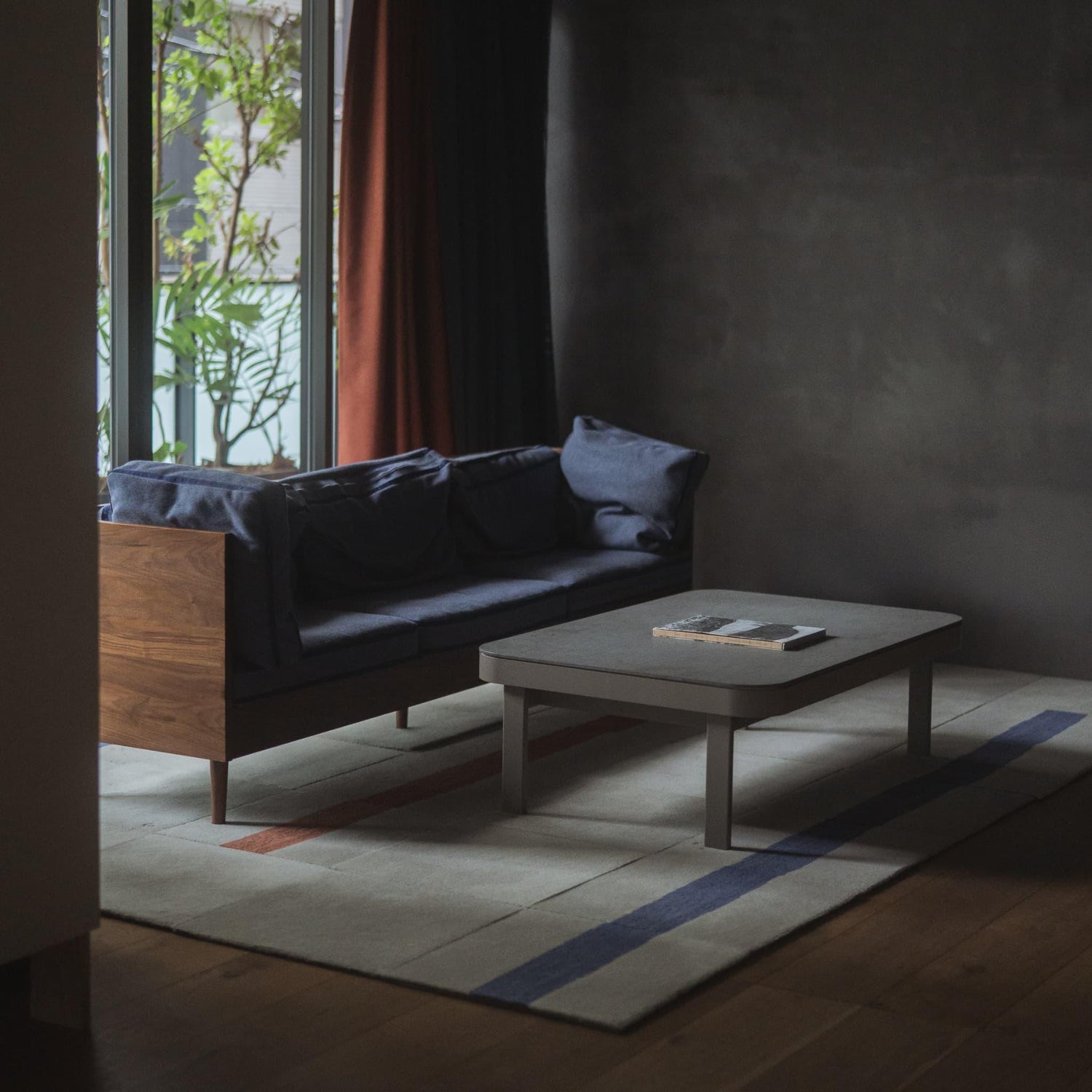
Japanese Calligraphy (Shodo): Art of the Brush
Share
Table of contents
Japanese Calligraphy: The Art of Expressing the Spirit Through Characters
Shodo, Japanese calligraphy, is an expressive art form that uses a brush called a "fude" and ink to write characters on paper, conveying thoughts and emotions through the written form. It is not simply the act of writing, but an art in which the writer's spirit is reflected in the characters. Shodo has a long history, having been introduced to Japan from China in the 6th and 7th centuries as a way of copying Buddhist sutras (Shakyo). It subsequently became ingrained as a form of cultivated learning, particularly among the aristocracy and samurai. Even today, shodo remains a familiar art form in Japan, with elementary school students learning the basics of calligraphy in a compulsory subject called "Shuji."
The expressive methods of shodo are extremely diverse due to the variety of factors involved, such as the writing style, the meaning of the characters, the size and type of brush used, and the individuality of the calligrapher. The appeal of shodo lies not only in the neatness of the form but also in the energy and expression of each character.
Exploring Japanese Calligraphy Styles
There are three main writing styles in modern shodo, and the same character can appear quite different depending on the style. Before learning about the writing styles, it is important to understand the concepts of "Hikkaku" (stroke order) and "Hitsuji" (stroke direction).
Each line that makes up a Kanji character is called a "Hikkaku." Kanji characters have a prescribed order in which the strokes are written, and this order is called "Hitsuji."
Based on these concepts, here is an introduction to the characteristics of each writing style, in order of difficulty

楷書 Kaisho (Block style)
Kaisho is the most basic writing style. It is the style generally used in Japan and is characterized by its ease of writing and reading. In Kaisho, all the strokes of a Kanji character are not written continuously; the brush is lifted from the paper after each stroke. Although there are a total of five types of Kaisho, including those not commonly used, it is considered to be the last writing style to have been developed.
行書 Gyosho (Semi-cursive style)
Gyosho is a writing style that emphasizes speed and fluidity without significantly distorting the Kaisho form. In some places, strokes are written continuously without lifting the brush, or strokes may be omitted or the stroke order changed. Since Gyosho is only a slight deviation from Kaisho, it is not difficult to read.
草書 Sosho (Cursive style)
Sosho is a writing style that was created for the purpose of writing quickly. It is characterized by its flowing lines and high artistic quality. However, because the strokes and stroke order of the characters are often abbreviated and the form is significantly different from the basic Kaisho style, it can be difficult to read without prior knowledge.
Tools of Shodo (Japanese Calligraphy)
This section introduces the essential tools required for shodo. The following four indispensable tools are collectively known as "Bunbou-Shihou" (Four Treasures of the Study):
Japanese calligraphy brush (Fude)
The four essential qualities of a good calligraphy brush, known as "Shitoku," are crucial factors to consider when choosing a brush. These are:
- "Sen" (尖): The tip of the brush is sharp and the hairs are gathered together, forming a fine point.
- "Sei" (斉): All the hairs of the brush are well-aligned and organized, ensuring even ink flow.
- "En" (円): The hairs of the brush form a neat conical shape, allowing for varied strokes.
- "Ken" (健): The hairs of the brush have moderate elasticity and resilience, providing control and responsiveness.
For beginners, calligraphy brushes are available with either white or brown hairs. Brushes with brown hairs are recommended for beginners.
Brown hairs are slightly stiffer and more resilient, making them easier to handle. They are particularly well-suited for Kaisho, a style that involves lifting the brush after each stroke. White hairs are softer and have less resilience, making them better suited for Gyosho and Sosho, styles that involve more fluid strokes. These are generally preferred by more experienced calligraphers.
Ink (Sumi)
Traditionally, the ink used in Japanese calligraphy is made by grinding solid ink sticks on an inkstone and mixing it with water. However, liquid ink, known as "Boku-ju," is commonly used today.
Traditional solid ink sticks, made from high-quality soot and glue, are far superior to liquid ink and remain unchanged even when exposed to air. Good-quality ink is not simply black; it possesses depth and nuance. Additionally, high-quality ink sticks are said to produce no sound when rubbed on the inkstone.
Inkstone (Suzuri)
The inkstone serves to grind and dissolve solid ink sticks and to hold the liquid ink. It features a flat surface for grinding the ink and a reservoir for the liquid ink.
Inkstones made of stone are necessary for grinding solid ink. The key to creating beautiful ink is to grind it slowly and gently with minimal pressure.
Hanshi (calligraphy paper)
This is the special paper used for Japanese calligraphy. The quality of the hanshi affects the ease of writing and how the ink appears, so it's important to choose one that suits you. Be careful when selecting hanshi, as paper with a very smooth surface tends to repel the ink, making it difficult to write on.
Understanding the Elements of Shodo
To fully appreciate shodo, it is important to understand the following three elements. These concepts provide a framework for evaluating calligraphy, both when practicing and appreciating the art. As shodo is an art form created by human hands, these elements can significantly influence the impression a piece makes on the viewer.
-
筆法 Hippou (Brush Method)
Hippou refers to the fundamental principles of calligraphy that should not be violated when writing characters. This includes aspects such as how to hold the brush, position the arm, and execute various brushstrokes. It encompasses the correct posture, grip, and movement of the brush to achieve proper form and control.
-
筆勢 Hissei (Brush Energy)
Hissei encompasses the characteristics of the lines created, influenced by the shape of the characters, the calligrapher's personality, and their mental state. It includes aspects such as the thickness and length of the lines, the use of straight and curved lines, and the energy and momentum conveyed through the strokes. Hissei reflects the dynamism and expressiveness of the calligrapher's hand.
-
筆意 Hitsui (Brush Intention)
Hitsui refers to the elegance and spirit expressed through the calligraphy. It reflects the calligrapher's intentions, mindset, feelings, and emotions, going beyond the physical aspects of the writing. Hitsui captures the deeper artistic and emotional qualities conveyed through the calligraphy, revealing the calligrapher's inner spirit.
A Beginner's Guide to Japanese Calligraphy
This section provides guidance on how to practice shodo.
Correct Posture for Japanese Calligraphy
Maintaining the correct posture is fundamental to producing beautiful calligraphy. Ensure that you sit facing the desk, with a slight gap between your stomach and the desk, keeping your back straight.
How to Hold a Calligraphy Brush
How you hold the brush is crucial in shodo, as it affects the shape of the characters and the quality of the lines. This falls under the principle of "hippou" mentioned earlier. Learning from the brush grips developed by calligraphers throughout history is fundamental to writing beautiful characters.
First, grasp the brush at the one-third point of the "hikan" (the handle of the brush).
There are two basic ways to position your fingers:
-
単鉤法 Tankōhō (Single Hook Method)
Hold the brush with your thumb, index, and middle fingers. When viewed from the front, only your index finger should be in front of the brush, while your middle finger supports it from behind. The remaining two fingers can lightly rest on your middle finger or gently grip the brush.
This method allows for greater freedom of movement and dynamic strokes, making it suitable for writing smaller characters. However, for children or beginners who may find it difficult to stabilize the brush, the Double Hook Method is recommended.
-
双鉤法 Sōkōhō (Double Hook Method)
In contrast to the Single Hook Method, in the Double Hook Method, your middle finger is also placed in front of the brush. The remaining two fingers are held the same way as in the Single Hook Method. This is the most common way to hold the brush, as it provides stability and is suitable for writing larger characters.
Initial Practice: Expressing with Lines
Practice writing various lines to familiarize yourself with using the brush and ink. Focus on controlling the brush's movements, such as "tomeru" (stopping), "harau" (sweeping), and "haneru" (flicking). As a general guideline, write straight lines quickly and curved lines slowly.
When loading the brush with ink, ensure that the ink reaches the base of the hairs. If only the tips are dipped, the base will not be properly saturated, resulting in uneven ink flow and hindering your ability to write effectively.
-
Vertical and Horizontal Lines
When practicing vertical and horizontal lines, start with a light touch from a distance and glide the brush smoothly to create the line. Avoid applying pressure when lifting the brush from the paper. Practice drawing lines with a consistent thickness from start to finish.
-
Zigzag Lines (Continuous Writing)
Practice writing continuous Z and V shapes. Write the Z shape in a zigzag motion from top to bottom, and the V shape from left to right, maintaining a light touch. In addition to keeping the lines the same thickness, practice alternating between thick and thin lines without lifting the brush to learn the rhythm of writing characters.
-
Circular Lines (Continuous Spiral Writing)
Practice writing continuous circular lines both clockwise and counterclockwise. Pay attention to keeping the thickness of the lines consistent during this exercise.
Recommended Kanji for Initial Practice
After practicing lines, try "臨書(rinsho)" (calligraphic copying). Rinsho involves imitating exemplary calligraphy pieces, adhering to the correct stroke order ("hitsujun").
A recommended kanji for beginners is "永" (Ei), meaning "eternity" or "long lasting." The reason for this recommendation lies not in its meaning but in its form.
In Japanese calligraphy, there is a saying, "Eijihappou" (Eight Methods in the Character "Ei"). This indicates that the character "永" embodies the eight essential points for beautiful calligraphy. By understanding and practicing this character, you can master the fundamental techniques of brush control.
永字八方 Eight Points for Beautiful Calligraphy
- Soku (側): A dot. Bring the brush down from left to right and press.
- Roku (勒): A horizontal line. Move the brush horizontally and stop firmly.
- Do (努): A vertical line. Move the brush straight down and stop firmly at the end.
- Teki (趯): A flick. Move the brush as if bouncing from a stopped position.
- Saku (策): An upward slanting line to the right. Unlike Roku, do not stop at the end but lift the brush.
- Ryaku (掠): A leftward sweep. Sweep the brush down to the left in a single stroke.
- Taku (啄): A short leftward sweep. Sweep the brush down to the left in a short, single stroke.
- Taku (磔): A rightward sweep. Slowly move the brush down to the right, stop once at the end, and then slowly lift the brush to the right.
Japanese calligraphy is an art form that reflects the spirit and individuality of the calligrapher. By understanding its history, styles, tools, and spirituality, you can gain a deeper appreciation for its beauty. By taking up the brush yourself and experiencing the world of shodo, you may discover new insights and be moved by its profound artistic expression.

















